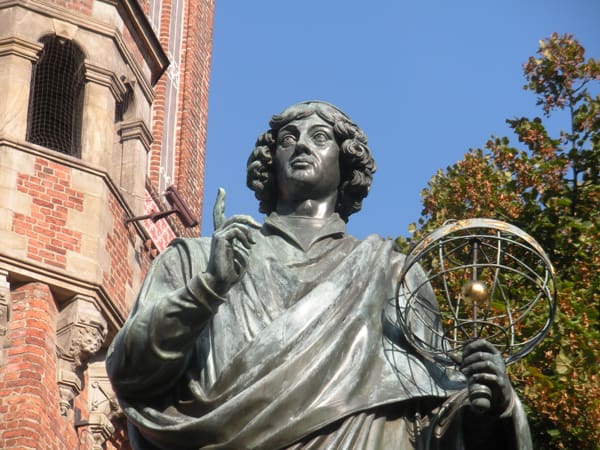By Merle Rosenstein
Poland’s world-famous sons and daughters excelled in many fields such as physics, music, astronomy and film. Homage has been paid to iconic religious and political leaders daring to hold unpopular views and forging ahead with new ideas through monuments, museums, and tours that follow in their footsteps. Now you can trace the path of famous Poles to get a glimpse of Poland’s past and understand how circumstances shaped great minds. Daniel LoboWarsaw
Daniel LoboWarsaw
Warsaw, the capital of Poland was destroyed during the Second World War and took years to rebuild. The city was meticulously reconstructed and displays a fascinating range of architectural styles. Famous citizens Fryderyk Chopin, Maria Sklodowska-Curie and Pope John Paul II spent time in Warsaw and considered it home.
Chopin’s family moved to Warsaw in 1810 where he studied music and played his first concerts. Walk the same streets as Chopin did to see his childhood home and the palaces and churches where he performed. Stop at the Kazimierzowski Palace on the Royal Route, where the Chopin family had an apartment on the second floor. Look for the bas relief of Fryderyk Chopin, with an inscription stating that the composer lived there from 1817 to 1827.
The Fryderyk Chopin Museum is a five-storey interactive exhibition that contains the world’s largest collection of Chopin memorabilia and personal items like manuscripts of Chopin’s works, correspondence, notes and his piano. Most notable in the collection are a death mask and a cast of Chopin’s hand.
 Maria Sklodowska-Curie was born in Warsaw in 1867 and studied at the Sorbonne where she met her husband Pierre. The Curies discovered polonium and radium and received a Nobel Prize in physics in 1903 with Henri Becquerel. Although Sklodowska-Curie spent much of her life in Paris, many places in Warsaw serve as reminders of her time there. A museum for the famous scientist was established in the home where she was born, even though Sklodowska-Curie lived at this address only for a very short time. The collection contains personal items, replicas of her laboratory, equipment and containers and personal photographs.
Maria Sklodowska-Curie was born in Warsaw in 1867 and studied at the Sorbonne where she met her husband Pierre. The Curies discovered polonium and radium and received a Nobel Prize in physics in 1903 with Henri Becquerel. Although Sklodowska-Curie spent much of her life in Paris, many places in Warsaw serve as reminders of her time there. A museum for the famous scientist was established in the home where she was born, even though Sklodowska-Curie lived at this address only for a very short time. The collection contains personal items, replicas of her laboratory, equipment and containers and personal photographs.  Chris BrownBorn Karol Jozef Wojtyla in the small town of Wadowice in Poland, Pope John Paul II was the first non-Italian pope to ascend to the papacy in 455 years, modernizing the Church and consulting with heads of state to influence world events. During seven return visits to Poland, the Pope always came to the capital. Many sites in Warsaw are reminiscent of the Pope’s meetings with world leaders or Polish citizens, or of religious ceremonies and masses he led. For example, in 1987, the Pope met with Mother Teresa of Calcutta at the Metropolitan Cathedral of the Martyrdom of St. John the Baptist, the oldest church in Warsaw.
Chris BrownBorn Karol Jozef Wojtyla in the small town of Wadowice in Poland, Pope John Paul II was the first non-Italian pope to ascend to the papacy in 455 years, modernizing the Church and consulting with heads of state to influence world events. During seven return visits to Poland, the Pope always came to the capital. Many sites in Warsaw are reminiscent of the Pope’s meetings with world leaders or Polish citizens, or of religious ceremonies and masses he led. For example, in 1987, the Pope met with Mother Teresa of Calcutta at the Metropolitan Cathedral of the Martyrdom of St. John the Baptist, the oldest church in Warsaw.
Krakow
Krakow miraculously survived the devastation of the Second World War and buildings in the medieval, renaissance, baroque and Art Nouveau styles remain intact. The Main Market Square occupies a major part of the Old Town. Cloth Hall is the oldest commercial centre in Poland. Overlooking the city is Wawel Hill, were the Royal Castle stands. The Wawel Cathedral is the place where kings were crowned and buried, and not far from Wawel Hill, Kazimierz, the old Jewish quarter, is alive with concerts and exhibitions of Jewish culture.
Four hundred years ago Nicolaus Copernicus proved that the earth moves around the sun and not the other way around. His theory, the Copernican Resolution, heralded a new era of science. The Nicolaus Copernicus Monument in Krakow pays tribute to the astronomer who studied at the Krakow Academy. The statue is in Krakow’s Planty Park. Jason RiedyGdansk
Jason RiedyGdansk
The 1,000-year-old city of Gdansk, is where the Solidarity movement in Poland gained momentum. Lech Walesa led the strike at the Lenin Shipyard in Gdansk in August 1980 that was one of the events leading to the end of communism in Poland. In 1983 Walesa won the Nobel Peace Prize.
Today Gdansk is a modern city and one of the host cities of the European Football Championships UEFA EURO 2012™. The main town developed along two main streets – the Uliga Dluga and the Dlugi Targ, now lined with historical monuments, art galleries and jewelry shops. The Gothic Town Hall and the Artus Court hosted royalty. The Neptune Fountain is the focal point for the Gdansk summer art festival and the Dominican Fair.
More information on travel to Poland can be found at www.poland.travel


